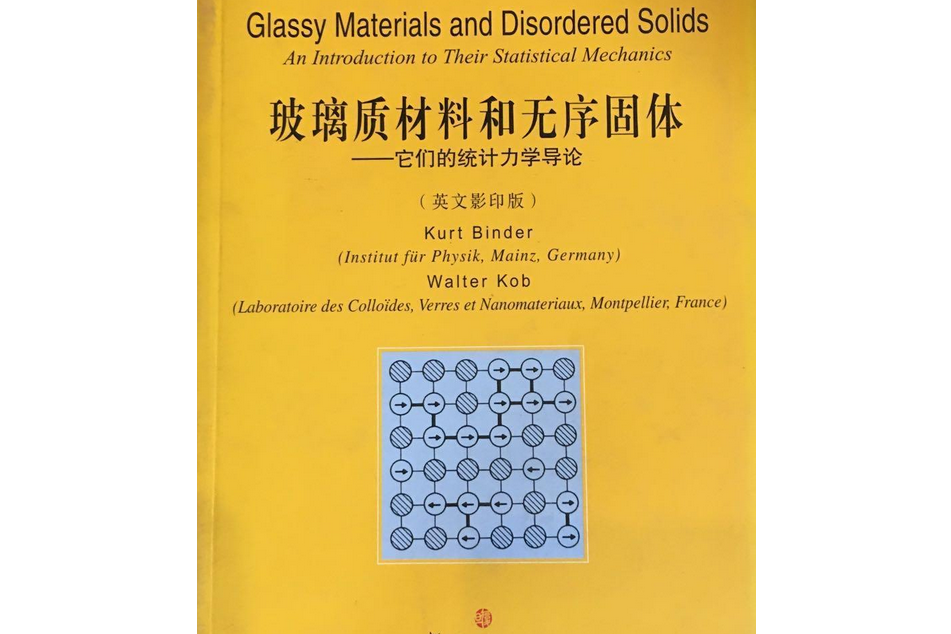《玻璃質材料和無序固體:它們的統計力學導論(英文影印版)》是2006年出版的圖書,作者是Kurt Binder、Walter Kob。
基本介紹
- 中文名:玻璃質材料和無序固體:它們的統計力學導論(英文影印版)
- 作者:[德]Kurt Binder、 [法]Walter Kob
- 出版時間:2006年11月
- 出版社:復旦大學出版社
- ISBN:7309052072
- 定價:45 元
- 開本:32 開
- 裝幀:平裝
- ISBN:7-309-05207-2/O.379
內容簡介,圖書目錄,
內容簡介
對於研究生而言,玻璃質材料和無序固體是比結晶固體更加廣泛、更加具有挑戰性的研究領域,這也是迄今為止學術界還沒有形成普遍共識和前後統一的理論的一個領域。本書的兩位作者都是該領域的知名專家,成書之前第一作者曾在德國美因茨(Mainz)的Johannes Gutenberg大學講課多年。可以說,這是填補該領域教科書空白的一部力作。
全書共分5章,第一章以教科書的方式,簡要評述無序物質的模型和它的統計力學的普遍概念。第二章講述無序物質的結構和動力學。第三章為無序結構的模型,其中以無規行走來討論柔性聚合物構型的模型,從滲濾理論出發討論分形結構等。第四章講述無序物質的普遍概念和物理特性,包括聚合物動力學的Rouse模型、套用滲濾問題處理物理系統、分形結構的元激發、無定形固體的物理性質、自旋玻璃體等。第五章講述超冷流體和玻璃體相變,包括形成玻璃體的唯象模式、慢弛豫模型和玻璃體相變的模ˉ耦合理論等。各章之後都有大量參考文獻,供深入研究參考。
這本可讀性較強的教科書將緊緊抓住學生的心,讓你懂得如此廣泛的領域具有許多共同的特徵,亦即表明在統計力學的框架內可以給予很好的描述。本書同樣適用於作為研究無定形材料的研究人員、理論工作者和實驗人員的標準教本。
圖書目錄
Preface
1. Introduction
1.1 Models of Disordered Matter: A Brief Overview
1.2 General Concepts on the Statistical Mechanics of Disordered Matter
1.2.1 Lattice Models
1.2.2 Averaging in Random Systems: Quenched versus
Annealed Disorder
1.2.3 "Symmetry Breaking" and "Ergodicity Breaking"
1.2.4 Configurational Entropy versus "Complexity",and the Kauzmann Paradox
2. Structure and Dynamics of Disordered Matter
2.1 Pair Distribution Functions and the Static Structure Factor
2.2 Topological Disorder and Bond Orientational Correlations
2.3 General Aspects of Dynamic Correlation Functions and Transport Properties
3. Models of Disordered Structures
3.1 Random Walks: A Simple Model for the Configurations of Flexible Polymers
3.2 Percolation: A First Example of a Fractal Structure
3.2.1 The Percolation Probability and Percolation Threshold
3.2.2 Diluted Magnets and Critical Exponents
3.2.3 The Fractal Dimensionality and the Concept of Finite Size Scaling
3.2.4 Scaling of the Cluster Size Distribution
3.2.5 Percolation for Low and High Lattice Dimensions
3.2.6 Rigidity Percolation
3.3 Other Fractals (Diffusion-Limited Aggregation, Random Surfaces, etc.)
3.3.1 General Concepts on Fractal Geometry
3.3.2 Diffusion-Limited Aggregation
3.3.3 Growth of Random Interfaces
3.4 Random Close Packing
3.5 Continuous Random Networks
3.6 Chemically Realistic Models of Structural Glasses
4. General Concepts and Physical Properties of Disordered Matter
4.1 The Rouse Model for Polymer Dynamics: A Simple Example for the Consequences of the Random Walk Picture
4.2 Application of the Percolation Problem to Physical Systems
4.2.1 Percolation Conductivity and a Naive Treatment of the Elasticity of Polymer Networks
4.2.2 Excitations of Diluted Magnets Near the Percolation Threshold
4.2.3 Effective Medium Theory
4.3 Elementary Excitations of Fractal Structures
4.3.1 Diffusion on a Percolation Cluster: The "Ant in the Labyrinth"
4.3.2 The Spectral Dimension and Fracton Excitations
4.3.3 The Sol-Gel Transition Revisited
4.4 Physical Properties of Amorphous Solids
4.4.1 Two-Level Systems
4.4.2 Anomalies of Glasses at Intermediate Temperatures:Excess Specific Heat, Thermal Conductivity Plateau, and Boson Peak
4.5 Spin Glasses
4.5.1 Some Experimental Facts about Spin Glasses:Systems and Physical Properties
4.5.2 Theoretical Models
4.5.3 The Replica Method and the Mean Field Theory of the Ising Spin Glass
4.5.4 Replica Symmetry Breaking
4.5.5 Spin Glasses Beyond Mean Field Theory
4.6 Variants and Extensions of Spin Glasses
4.6.1 p-Spin Interaction Spin Glasses and the Random Energy Model
4.6.2 Potts Glasses
4.6.3 Quadrupolar Glasses as Models for Diluted Molecular Crystals
4.6.4 Atomistically Realistic Models of Diluted Molecular Crystals
4.6.5 Spin Models with Quenched Random Fields
5. Supercooled Liquids and the Glass Transition
5.1 Phenomenology of Glass-Forming Systems
5.2 Models for Slow Relaxation
5.2.1 The Theory of Adam and Gibbs
5.2.2 The Free Volume Theory
5.2.3 Kinetically Constrained Models
5.3 The Mode-Coupling Theory of the Glass Transition
5.3.1 The Zwanzig-Mori Projection Operator Formalism
5.3.2 The Mode-Coupling Approximations
5.3.3 The Mode-Coupling Theory of the Glass Transition
5.3.4 Predictions of Mode-Coupling Theory
5.3.5 The Relaxation Dynamics of Glass-Forming Liquids and Test of the Predictions of MCT
5.3.6 Concluding Remarks on Mode-Coupling Theory
Index

